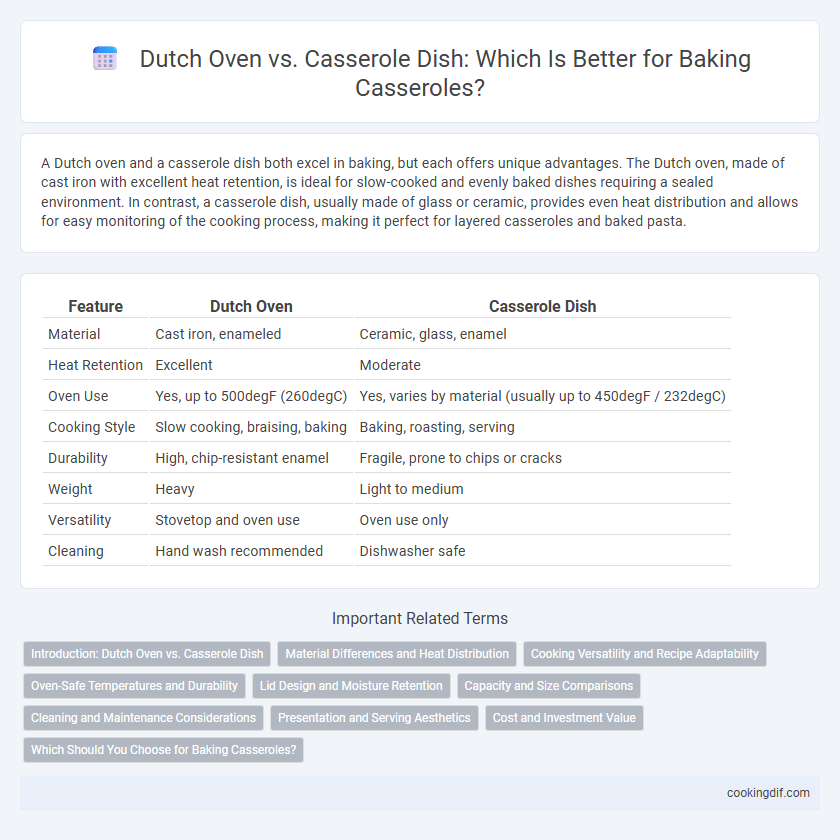A Dutch oven and a casserole dish both excel in baking, but each offers unique advantages. The Dutch oven, made of cast iron with excellent heat retention, is ideal for slow-cooked and evenly baked dishes requiring a sealed environment. In contrast, a casserole dish, usually made of glass or ceramic, provides even heat distribution and allows for easy monitoring of the cooking process, making it perfect for layered casseroles and baked pasta.
Table of Comparison
| Feature | Dutch Oven | Casserole Dish |
|---|---|---|
| Material | Cast iron, enameled | Ceramic, glass, enamel |
| Heat Retention | Excellent | Moderate |
| Oven Use | Yes, up to 500degF (260degC) | Yes, varies by material (usually up to 450degF / 232degC) |
| Cooking Style | Slow cooking, braising, baking | Baking, roasting, serving |
| Durability | High, chip-resistant enamel | Fragile, prone to chips or cracks |
| Weight | Heavy | Light to medium |
| Versatility | Stovetop and oven use | Oven use only |
| Cleaning | Hand wash recommended | Dishwasher safe |
Introduction: Dutch Oven vs. Casserole Dish
Dutch ovens, typically made from cast iron with a heavy lid, provide superior heat retention and even cooking, making them ideal for slow-cooked recipes and crusty breads. Casserole dishes, often ceramic or glass, offer versatility and ease of cleaning, perfect for oven-to-table presentations and baked casseroles with a crisp topping. Choosing between the two depends on desired cooking style, heat distribution, and presentation needs.
Material Differences and Heat Distribution
A Dutch oven is typically made of cast iron with an enamel coating, offering excellent heat retention and even distribution, ideal for slow-cooking and baking. In contrast, casserole dishes are often made from ceramic, glass, or stoneware, providing moderate heat conductivity but less even heat distribution compared to cast iron. The dense, heavy construction of a Dutch oven promotes consistent cooking temperatures, while casserole dishes may cause hotspots, affecting baking results.
Cooking Versatility and Recipe Adaptability
Dutch ovens offer superior cooking versatility with their ability to withstand high oven temperatures and stovetop use, making them ideal for recipes requiring both searing and slow-cooking. Casserole dishes, primarily ceramic or glass, excel in even heat distribution and presentation but lack stovetop compatibility. Recipe adaptability favors Dutch ovens for braises, stews, and bread baking, while casserole dishes suit baked pasta, gratins, and layered casseroles.
Oven-Safe Temperatures and Durability
Dutch ovens typically withstand oven-safe temperatures up to 500degF, making them ideal for high-heat baking and roasting, while casserole dishes usually have lower temperature limits around 350degF to 400degF depending on the material. Cast iron Dutch ovens offer exceptional durability and heat retention due to their thick construction, whereas ceramic or glass casserole dishes require careful handling to prevent cracking under thermal shock. Choosing between the two depends on the desired cooking temperature and the importance of long-term resilience in your bakeware.
Lid Design and Moisture Retention
Dutch ovens feature heavy, tight-fitting lids designed to trap steam effectively, promoting superior moisture retention during baking. Their thick cast iron construction evenly distributes heat while the lid's design ensures a self-basting environment that keeps casseroles juicy and tender. In contrast, casserole dishes often have lighter, less airtight lids that allow more moisture to escape, resulting in a drier texture.
Capacity and Size Comparisons
Dutch ovens typically offer larger capacities ranging from 4 to 7 quarts, making them ideal for baking larger casseroles or meals requiring ample space. In contrast, casserole dishes commonly range between 1.5 to 4 quarts, designed for moderate portions and easier storage. The choice between a Dutch oven and a casserole dish for baking largely depends on the desired serving size and the oven space available.
Cleaning and Maintenance Considerations
Dutch ovens typically feature enameled cast iron surfaces that resist staining and are dishwasher safe, simplifying cleaning and long-term maintenance. Casserole dishes, often made from ceramic or glass, require careful handling to prevent chips and cracks, and may need hand washing to preserve their glossy finish. Both options benefit from prompt cleaning to avoid food residue buildup, but Dutch ovens generally offer greater durability and ease of upkeep.
Presentation and Serving Aesthetics
A Dutch oven offers rustic charm with its heavy cast iron construction and enamel coating, maintaining heat that ensures evenly baked dishes while doubling as an attractive serving vessel straight from oven to table. Casserole dishes, often ceramic or glass, provide a more polished and elegant presentation, allowing the vibrant colors and textures of baked meals to shine through for visually appealing servings. Both options enhance serving aesthetics, but the Dutch oven leans towards cozy, hearty appeal whereas casserole dishes emphasize refined, colorful presentation.
Cost and Investment Value
Dutch ovens generally have a higher upfront cost due to their heavy-duty cast iron construction and enamel coating, offering excellent heat retention and durability for long-term investment. Casserole dishes, typically made from ceramic or glass, are more affordable but may wear out faster and provide less even heat distribution, impacting their overall value. Investing in a Dutch oven provides greater versatility and longevity, making it a cost-effective option for frequent bakers despite the initial price.
Which Should You Choose for Baking Casseroles?
A Dutch oven offers superior heat retention and even cooking due to its heavy cast iron construction, making it ideal for slow-cooked casseroles that benefit from consistent temperatures. Casserole dishes, often made from ceramic or glass, provide better visibility and are lightweight, perfect for baked casseroles requiring shorter cooking times and visually appealing presentations. Choose a Dutch oven for durability and depth of flavor development, while a casserole dish suits ease of handling and serving.
Dutch oven vs casserole dish for baking Infographic

 cookingdif.com
cookingdif.com